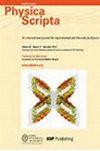Deep learning of plausible bandgaps in dispersion curves of phononic crystals
IF 2.6
3区 物理与天体物理
Q2 PHYSICS, MULTIDISCIPLINARY
引用次数: 0
Abstract
Phononic crystals represent an interesting class of metamaterials that can be utilized to regulate or manipulate vibration, sound propagation, and thermal transport. Their useful features mainly arise from the bandgaps in their dispersion curves, preventing the passage of waves within specific frequency ranges. However, it is often costly and time-consuming to obtain the dispersion curves, and the reverse engineering of phononic crystals to have pre-defined bandgaps possesses even greater challenges. In this research, we address this issue by employing a deep artificial neural network to predict the bandgap ratio and the characteristics of plausible bandgaps, focusing on the localized resonance in columnar phononic crystals. We utilized two geometric parameters, i. e. the ratio of diameter and height of the cylindrical resonators relative to the lattice constant, achieving a determination coefficient of 0.9993 for predicting the characteristics of the bandgaps and 0.9827 for predicting the bandgap ratio. To verify the model and better understand its behavior, we introduce Shapley values. These values provide a comprehensive insight into how each geometric parameter influences the predicted bandgap ratios.声子晶体频散曲线中可信带隙的深度学习
声波晶体是一类有趣的超材料,可用于调节或操纵振动、声音传播和热传输。它们的有用特性主要源于其频散曲线中的带隙,阻止特定频率范围内的波通过。然而,获取频散曲线通常既费钱又费时,而对声子晶体进行逆向工程以获得预定义带隙则面临更大的挑战。在本研究中,我们针对这一问题,采用深度人工神经网络预测带隙比和可信带隙的特征,重点研究柱状声子晶体的局部共振。我们利用两个几何参数,即圆柱谐振器的直径和高度相对于晶格常数的比率,预测带隙特性的确定系数达到 0.9993,预测带隙比的确定系数达到 0.9827。为了验证模型并更好地理解其行为,我们引入了夏普利值。通过这些值,我们可以全面了解每个几何参数对预测带隙比的影响。
本文章由计算机程序翻译,如有差异,请以英文原文为准。
求助全文
约1分钟内获得全文
求助全文
来源期刊

Physica Scripta
物理-物理:综合
CiteScore
3.70
自引率
3.40%
发文量
782
审稿时长
4.5 months
期刊介绍:
Physica Scripta is an international journal for original research in any branch of experimental and theoretical physics. Articles will be considered in any of the following topics, and interdisciplinary topics involving physics are also welcomed:
-Atomic, molecular and optical physics-
Plasma physics-
Condensed matter physics-
Mathematical physics-
Astrophysics-
High energy physics-
Nuclear physics-
Nonlinear physics.
The journal aims to increase the visibility and accessibility of research to the wider physical sciences community. Articles on topics of broad interest are encouraged and submissions in more specialist fields should endeavour to include reference to the wider context of their research in the introduction.
文献相关原料
| 公司名称 | 产品信息 | 采购帮参考价格 |
|---|
 求助内容:
求助内容: 应助结果提醒方式:
应助结果提醒方式:


